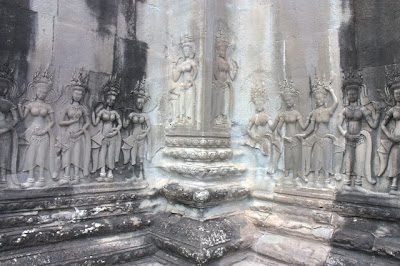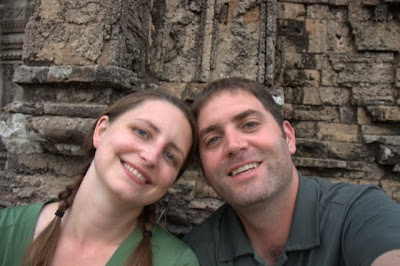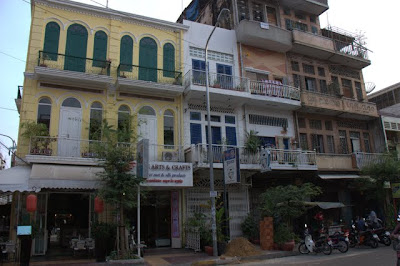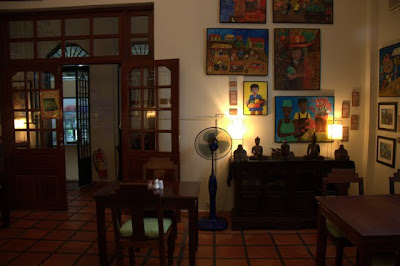Battambang: A Photo Essay
Since I just discovered how to make fancy black borders in WordPress, let’s get all fancy and call this a photo essay. Oooh.
Our time in Battambang was brief, but we fit in an awesome cooking class and an extensive tour of the surrounding countryside. Either one was worth the detour to Battambang alone.
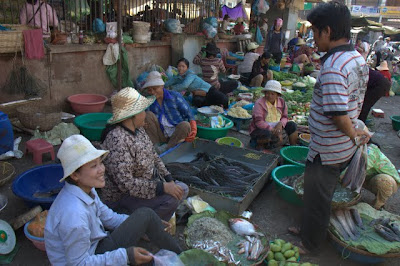
Our first priority in Battambang was signing up for that evening's cooking class at the Smokin' Pot. I learned about the class over at Lives of Wander; Theresa's right, it is one of the best deals in Asia and I'm happy to report it is still only $8 for a hands on, three dish class with a trip to the market. And unlike our trip to the market during our Thai cooking class, we actually purchased the meat and produce we'd be using in our meals.

Which means the fish swimming around in buckets became the fish for our fish amok after this lady chopped off its head.

Carrying the kaffir lime leaves and still warm chicken meat. Thank goodness our classmates voted for breast.

Like Thai cooking, Cambodian meals often start with a paste of spices and herbs ground by a morter and pestle. We used half this paste in our fish amok and the other for the spicy beef stir-fry.

Sean is turning into quite the master chef during our Asian travels. In the pan, the coconut milk, curry paste, and fish simmer for the fish amok.

When the cooking instructor said spicy beef, he meant SPICY beef. This was easily the most spicy dish we had during our six months in Asia, requiring lots of rice and water to get it down. And it only had two or three chilies, plus the ones in the paste. Our instructor told us when he makes this dish at home, each family members customizes the dish to their liking. He takes 7 chillies, his wife takes 10, and his mother in law takes a whopping 13. Spicy!

The next morning, we set off on a tour of the countryside by tuk tuk, with Philay as our guide. We didn't so much meet Philay as Philay met us, being the most patient and persistent of the horde of tuk tuk drivers that swarmed us as we got off the bus in Battambang. Tuk-tuking tourists is big business in Battambang, particularly because there are a lot more tuk tuk drivers than there are tourists, and countryside tours are the biggest score of all.
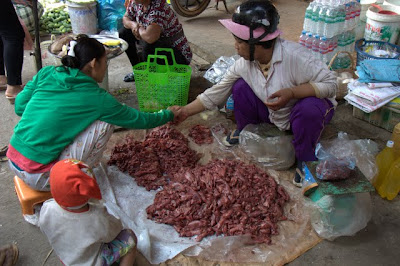
Our first stop of the morning was to a local market, where we were the only non-Cambodians in sight. You might think we would get sick of markets but you would be wrong. Asian markets never disappoint; there's always something to watch, something more colorful and outrageous than the previous market. For example, the mouse transaction above. Yes, mice.

And you can't leave without a chili chopper, at least Philay didn't think so. After passing by the live chili chopping in action, the Cambodian version of an infomercial, Philay decided his wife would really like a chili chopper too.

After the market, we stopped by a former Pepsi plant. According to our guidebook, Pepsi abandoned the plant in the 70s when the Khmer Rouge rolled in. According to Philay, the plant was still in operation until the Vietnamese took over in the 80s. Either way, it stands as it did decades ago, with glass bottles collecting dust on the inside.

When going over the day's itinerary, Philay kept asking us if we wanted to see a coke-a-die farm. A coconut farm? we said. Yes, a coke-a-die farm, he repeated. Okay, we said. We like coconuts. When we arrived, Philay paid the attendant some riel and took us over to this water pit. Oh, we both said in unison. A crocodile farm! Yes, Philay said. Like I said, a coke-a-die farm.

When the government neglected public transport for the locals, the locals came up with their own method of transport: a bamboo train. The "train" is nothing more than a slab of bamboo strips set on top of wheels, running in between the real trains. Today, I'm pretty sure it exists pretty much as a tourist trap, but we allowed ourselves to fall into the trap and off we went.

...making hurtling forward on the tracks on the unattached bamboo an interesting ride to say the least.

And oh yeah, if someone is coming in the opposite direction? One of the bamboo trains has to move. We got the boot.
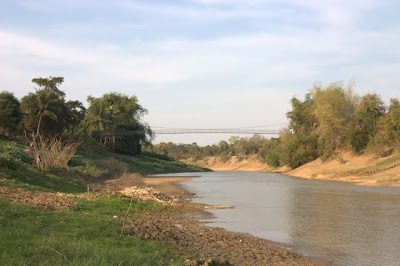
Next, we head to the riverfront, just as kids are on their way home from school and farmers finish their tasks in the late day sun.
We also do our good deed for the day; Philay stops to smoke some bats out of a tree next to a temple.

Philay seems very excited about our last stop - watching the sun set over a lotus farm - but we're a little rattled when we get there. Minutes before, on the big highway, we stopped at an accident scene that had happened right before we arrived. A man lays completely still on the side of the road. Philay learns a car ran him off his motorbike and he wasn't wearing a helmet. The lone Westerner at the scene is frantic. I can't get through to the police, he shouted, and half of this guy's head is gone! Philay agrees to drive to the police station to notify them. We start to take off when we hear sirens. Philay drives away without giving the accident a second thought. We, on the other hand, keep peppering him with questions. Cambodia has one of the highest traffic accident rates in the world; scenes like this are all too common. Unfortunately, because many people fail to wear their helmets, so are fatalities. Fines for driving without a helmet means you'll often see the male driver with a helmet, with female and child companions go without.

Philay was pleased when the lotus farm is teeming with bridal parties taking pictures. He'd been promising us weddings all day; we were never quite sure whether we were actually going to a wedding or just observing one. We're pleased we don't have to crash a wedding in our travel clothes. I pull myself together to resume my role as paparazzi. We learn Cambodian brides like big hair and big make-up on their wedding days, wear big colorful dresses that are the same color as the less ornate dresses worn by the bridesmaids, and decorate the cars in the same way Americans do.
Scenes from Angkor Wat: Day Two
After our long day exploring temples far and near on Day One, we took it easy on Day Two. We saved the two big ones for last: Angkor Wat itself (above) and Ta Prohm (think Lara Croft Tomb Raider style). Both are crowded, but you can find quiet spots for some solitude.
Angkor Wat
Ta Prohm
Scenes from Angkor Wat: Day One
The temple complex of Angkor Wat is a UNESCO World Heritage site and one of the great ruins of the world. Angkor likely was the largest preindustrial city in the world, with an elaborate system of infrastructure connecting an urban sprawl of at least 1000 square kilometres to the well-known temples at its core. It served as the seat of the Khmer Empire, which flourished from approximately the 9th to 13th centuries.
We spent two hot, sweaty days dodging persistent vendors and exploring a portion of the ruins, scrambling up and down rocks and stairs to marvel at the grandeur and intricacy of the temples. Here’s scenes from some of the temples we visited on day one:
Angkor Thom
Preah Khan (I think!)
Ta Som
Banteay Srei
Pre Rup
p.s. Happy St. Patrick’s Day!
Ten Postcards for a Dollar
We were torn about how much time to spend touring Angkor Wat. There are definite advantages of taking it slow, but in the end we made the right decision for us. We bought a three-day pass, but only used it for two days. Honestly, we probably could have seen everything we saw in a day, but spreading it out over two days allowed us to not rush and take a ride out to one of the temples that is further away (Banteay Srei). We had somewhat of a limited timeframe in Cambodia, and spending less time at Angkor Wat allowed us to add in a stop to Battambang. We had no desire to spend more time in Siem Reap; as far as I’m concerned, its only redeeming quality is the passion fruit pastries at Blue Pumpkin. As far as Angkor Wat itself, we liked seeing the ancient ruins, but neither of us are enthusiasts of ancient history and were happy with what we got to see in two days.
Another factor of why we chose to limit our time at Angkor Wat was because the experience was a bit frustrating at times. We tried to time our visits to minimize chances of huge crowds (and admittedly, spreading out our time would have allowed us to do this even more), but we were there at the height of high season and all of the strategies in the world wasn’t going to change the fact that there were just an awful lot of people trying to look at the same things we were trying to look at. The ruins at Angkor are majestic and grand and amazing, especially if you consider people carved them by hand, but the actual experience of looking at them in January 2011? Sean doesn’t agree with me, but I may have enjoyed our time peacefully riding around Sukhothai more.
We’re used to people trying to sell us stuff overandoverandover, but the vendors at Angkor Wat take it to a whole new level. At the Taj Mahal, for instance, people hassle you at the door, and with exception of a guy or two suggesting that you should give him some rupees because of his previous suggestion that you might get a nice reflection of Taj if you take a photo right here, you essentially are left alone until you leave. But at the temples of Angkor, you have to go through the hassling at every single stop you make. It got to the point where I didn’t want our driver (we rented a tuk-tuk to get around) to stop at any of the minor temples because I just didn’t feel like running the gauntlet of people trying to sell me crap I didn’t want or need. We subscribe to the philosophy of killing them with kindness, and always kept our cool despite wanting to scream PLEASE LEAVE ME ALONE, but nothing stopped the barrage of sales tactics besides getting deep enough into the temple such that the person wouldn’t follow you anymore. Except then there’d be a little girl, no more than four, coming at you from around the corner, after being sent over by her mother keeping a watchful eye from afar.
It is no secret that the children in Siem Reap are the hardest to resist. It is one thing to tell an adult no rather brusquely for the tenth time in a row; it is another to do that to a child. We tried striking up a conversation about something other than the postcards or water or books that they are trying to sell you, but these children are onto to such tactics. Some, especially the younger ones, could be swayed, especially if you could figure out a question that wasn’t part of their script, but many were determined to stay on track. You see, they’ve been trained to handle diversionary tactics. They’ll tell you their name, they’ll count from one to ten in English, they’ll tell you your president is Barack Obama and his daughters are Sasha and Malia, they’ll tell you they learned such facts in school, and they’ll tell you they already are done with school for the day. And as soon as they finish with their encyclopedic knowledge of your country, they’ll jump right back into their spiel: so, you buy some postcards, mister? Only ten for a dollar!
One group of little girls followed us for quite a way, well after we tried striking up a conversation and well after we told them firmly that we were not going to buy anything. There were only two originally, but as we walked towards the bathrooms, two others joined in. When I came out of the bathroom, Sean was sitting on a bench, waiting for me, while the group of girls stood as far as they were allowed to go, holding out postcards towards Sean, chanting ten postcards for a dollar, ten postcards for a dollar in deadened, flat voices that sounded like zombies.
I was tempted to grab Sean and run away. Enough is enough; we were not going to buy the stupid postcards, no matter how persistent they were. But it breaks my heart to see children reduced to nothing more than salespeople by manipulative adults. So, I continued chatting with the girls, told them again we weren’t going to buy any postcards, and asked them if they would like to have their picture taken with me, which at least got them to snap out of the zombie act and crack small smiles. But, of course, seconds after showing the girls their picture on my camera, they were back to ten postcards for a dollar, at least with a little more liveliness this time.
Scenes from Phnom Penh
Phnom Penh: a little charming, a little grungy, a little chaotic, but always interesting. Our favorite part of being in Phnom Penh was dining in the plethora of restaurants and cafes run by NGOs. It would be easy to eat every meal in Phnom Penh at such places; save for a couple of meals, we pretty much did. And why not? All of the restaurants we tried had stylish decor and tasty food; the fact that your money goes to a good cause is icing on the cake. We ate at Friends, one of the originals, staffed by former street children and their teachers; Romdeng, started by one of the former waiters at Friends; Cafe Yejj, a cafe employing at-risk women to try to break the cycle of poverty; and Ebony Apsara Cafe & Boutique, where a portion of the proceeds go to re-developing Cambodia’s arts scene. Yum.

We stayed in a guesthouse over a bar run by a Texan ex-pat and his Cambodian wife. Finding a slice of America in Cambodia means you have to take the good (live AFC Championship games, Iron City can spottings, American-style meals) with the bad (Confederate flag displays and Fox News over breakfast).

Also good: the owner's adorable teenage sister who worked the bar after school. She had the biggest dimples and the most outgoing, upbeat personality.

The bustling Russian market, so named for the abundance of Russian goods available during Vietnamese occupation in the eighties. Thanks to the abundance of clothing factories around Phnom Penh, you can find discounted brand name clothes, even in "big sizes, for westerners." I almost bought a Gap dress but declined the temptation at the last minute. The girls at our guesthouse were amazed we didn't buy anything.

A street full of trendy shops, including a chocolatier (with delicious chocolate laced with Kampot pepper)














